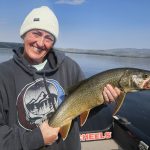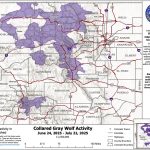Column: Are wolves good for the local economy?
Who are the ones getting depredated here, anyway?
Grand County Enterprise

New Mexico Department of Game and Fish/Courtesy photo
It’s happened right here near Granby.
A fishing-person friend of mine was angling along the Fraser River when he noticed what he thought was a dog sitting on the opposite bank staring at him. He was by himself. As he looked more closely at this “dog,” he noticed that it had a radio collar and somehow looked different than a dog. It was a wolf.
‘We had a brief little staring match there by the river and then he went along on his own business,” my friend said. “It was pretty amazing.”
I envied him because he had just seen a wolf. I have yet to see a wolf in the wild. Maybe, perhaps, I’ve heard some howling. Not sure.
Which got me to thinking about this entire wolf reintroduction experiment and my extremely ambivalent feelings about the entire affair.
For anyone who has been living like an ostrich, Colorado voters, perhaps addled by Covid, approved a 2020 ballot initiative that directed Colorado Parks and Wildlife to develop a plan and reintroduce gray wolves west of the Continental Divide by the end of 2023.
CPW has followed the directive and now 25 gray wolves have been released into the state, the first batch being dumped in Grand and Summit counties with the second releases taking place in Eagle and Pitkin counties.
The controversy and odd outcomes of the effort have continued unabated.
Wolves have killed, or “depredated,” cattle and sheep in Grand County and in other locale’s where they’ve been relocated. The predictable outcry from the agricultural community has been vociferous, as it probably should be, and the offending wolves have been moved.
Or, if that didn’t work, the wolves themselves have been killed or “depredated,” to use a turn of phrase.
Now I am sure that it was horrible for these calves and sheep — and sometimes dogs, too — to be slaughtered mercilessly by wolves. Even worse, perhaps, has been the loss in money to ranchers who hoped to one day sell or breed those animals. It’s just unfortunate all around.
But I personally feel that the wolves have been subjected to an even more bizarre and awful sort of torture. The last batch of wolves flown in came from a part of the world where wolves are hunted from airplanes and helicopters or rounded up by snow machines and killed.
Then, some of those wolves, after living a harassed “depredated” lifestyle, were tranquilized and “transplanted” to a complete strange and foreign landscape and, well, released. It’s as if I woke up one morning after a deep sleep and found myself in a strange bed in, say, Vladivostok, Russia. With no help, no clues and no friends. And no food.
Many of those wolves may have wondered where the rest of their pack was. Some were released to wonder alone and, perhaps, get extremely lonely (they are pack animals). Some wandered without a pack and perhaps starved.
Others roamed over this strange landscape, full of more humans than usual, and simply wondered what to make of it all … only to probably be tranquilized again and transplanted again, only to wander alone again, and to be shot for no good reason by some bored coyote hunter, or harassed to death by other wolves.
It seems to me that life for these transplanted wolves isn’t so great. Neither is the life of cattle and sheep and their owners, here on the Western Slope. And then there are the human-imposed and nearly-impossible-to-resolve problems that are dumped into the laps of our Colorado Parks and Wildlife officers who must somehow figure out how to make this right. It’s darn near impossible all around.
So is it worth it to the wolves, the people, the sheep and the cute little lambs for people in the state to live their lives with the vague sense in their minds that there are wolves wondering around on Colorado’s Western Slope?
It’s that idea of a forgotten wildness, I think, that prompted people to vote yes for this measure. A measure approved by people from the urban corridor in Colorado, not by people who live with the wolves themselves.
We don’t need any more lone(ly) wolves, mangled sheep and calves and really angry ranchers. Let’s leave it like it is right now, in this sad and contradictory state of man-made wildness. That way perhaps a Front Range visitor can exclaim about hearing a howling wolf and locals can hope their pet dogs are safe, and the wolves can probably just wonder: “What the heck was that all about?”

Patrick Brower is the Enterprise Facilitator for the Grand Enterprise Initiative. He offers free and confidential business management coaching to anyone who wants to start or expand a business in Grand County. He is also the author of “KILLDOZER: The True Story of the Colorado Bulldozer Rampage.” He can be reached by calling 970-531-0632 or at patrickbrower@kapoks.org.

Support Local Journalism

Support Local Journalism
The Sky-Hi News strives to deliver powerful stories that spark emotion and focus on the place we live.
Over the past year, contributions from readers like you helped to fund some of our most important reporting, including coverage of the East Troublesome Fire.
If you value local journalism, consider making a contribution to our newsroom in support of the work we do.









